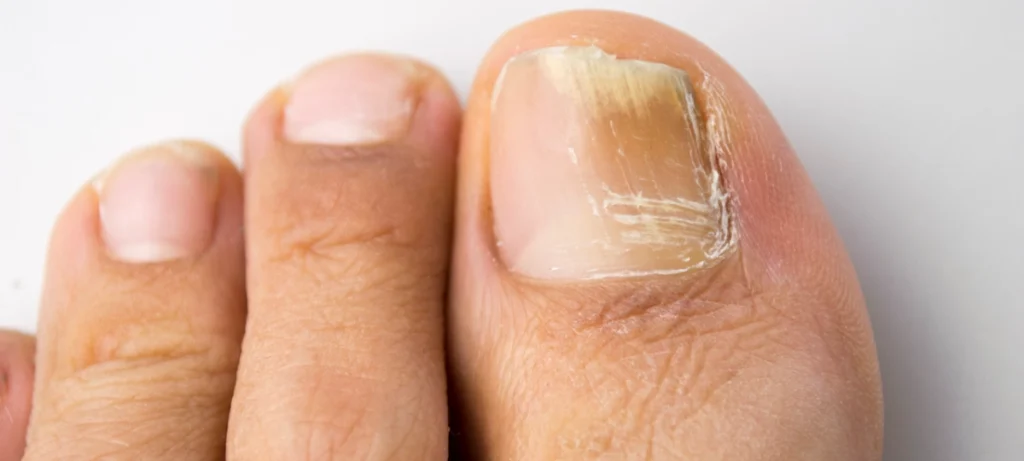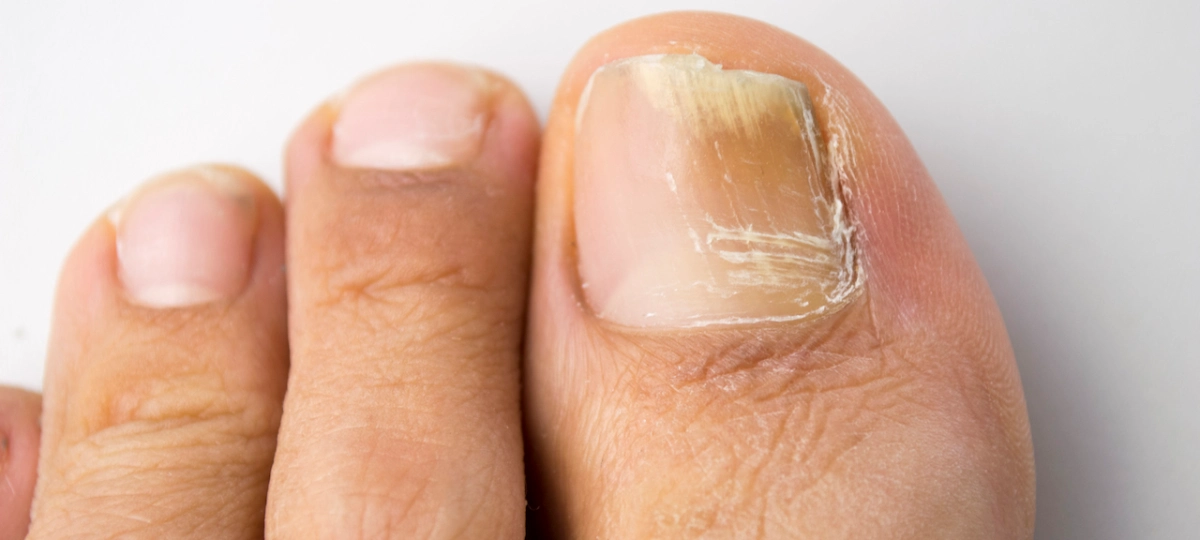Fungi, including yeast, can infect nails. The infections are more likely to affect the toenails than fingernails because fungus thrives in warm, moist environments like shoes.
Keeping your nails trim and dry, wearing breathable footwear, and avoiding shared nail grooming tools can help prevent infection. However, if symptoms develop, prescription antifungal medications—including oral ones such as terbinafine (Lamisil) or itraconazole (Sporanox)—are usually recommended.
Distal Subungual Onychomycosis (DSO)
The most common type of fungal nail infection, DSO, affects the underside and tip of the nail plate and starts at the hyponychium. The infection can cause the nail to become discolored, thickened, and brittle. Eventually, it may detach from the nail bed and cause pain. The fungi can also spread to other nails and to the skin around the nails.
While fungi can attack any part of the nail, DSO often occurs in the toenails and more commonly in the big toenails. It can be harder to treat than other types of fungi because it infects the underneath layer of the nail, and it is difficult for medications to reach this area. The infection can be very uncomfortable and may even cause pain when walking or using your feet.
A toenail fungus can be hard to diagnose without a sample of the affected nail to be examined under a microscope. A dermatophyte fungus is the most common cause of a toenail fungus, but other molds and yeasts can also infect the nails. The symptoms of a fungal nail infection typically include yellowish, brown, or white spots or streaks in the nails that are thick and brittle. In some cases, the nails may change shape or come off entirely.
Despite improvements in antifungal drugs, it can still take months for the nails to grow back. This can be exacerbated by other factors such as slow growth of the nails, thickening of the nail, or a host-related condition that can make treatment more challenging (e.g., diabetes mellitus, peripheral vascular disease, or immunocompromised patients) (26).
The best way to prevent fungal nail infections is to practice good hygiene. Be sure to wear shoes that let your feet breathe and avoid those with tight laces or seams. Also, wear breathable socks and change them regularly. Wash your feet and the skin around them frequently to remove moisture. Lastly, avoid going barefoot in public areas like showers, locker rooms, and swimming pools. You should also avoid putting pressure on your toes when wearing shoes.

White Superficial Onychomycosis (WSO)
If left untreated, fungal nails can grow to become brittle and discolored. While this condition is not life-threatening, it can cause discomfort and embarrassment, especially when the affected nail is on a visible part of the body such as your feet. Fungal nail infections are usually caused by fungi that thrive in environments where there is prolonged contact with moisture and warmth. Those with sweaty feet or socks, or those who suffer from a weakened immune system are particularly vulnerable to fungal nail infections. Fortunately, there are a number of treatments available to prevent and treat fungal nail infections.
White superficial onychomycosis (WSO) is characterized by the presence of a large, opaque white plaque in the distal portion of the nail plate. This type of nail infection is less common than proximal subungual onychomycosis or DSO and is most often due to Trichophyton interdigitale in healthy adults. However, it can also be caused by Trichophyton rubrum in children or patients with HIV infection. In a few cases, the responsible agent may be members of the mold genus Scytalidium (formerly known as Neoscytalidium), or the bacterium Fusarium solani.
WSO is a subtype of onychomycosis that differs from DSO and PSO in its epidemiological characteristics and clinical features. In addition to the large white plaques, these nails are also typically dull and brittle. WSO is often recurrent and difficult to eradicate, although a number of studies have shown that terbinafine treatment lasting 6 weeks produces better clinical results than a shorter regimen.
In a few cases, the fungus that causes WSO can develop to invade the entire nail and lead to total dystrophic onychomycosis. This condition is more difficult to treat than DSO and PSO, but it can be cured in some patients. In one study, periodic removal of the whitish nail plates in conjunction with antifungal topical treatment produced a cure in 2 children within 6 months. In another study, patients with a clinical diagnosis of WSO who were treated for 8 weeks with a combination of terbinafine and ciclopirox had a high rate of cure (50%).
Candida Onychomycosis
As the name suggests, candida onychomycosis is a fungal nail infection caused by the fungus Candida albicans. It typically affects the fingernails, though it can also infect toenails. Symptoms of this condition include thickened and discolored nails that are difficult to grow out normally. In some cases, the nails may even start to come apart from the skin around them. This type of infection can be very painful, and it can have a negative impact on one’s self-esteem and quality of life.
Despite its common presence, onychomycosis is not well understood or treated by physicians. This is partly due to the perception that the disease is a cosmetic concern only, and that it would not be worth the effort required for successful treatment. This view is perhaps also influenced by the poor results of previous antifungal agents, which are generally associated with unpleasant adverse effects and long dosing courses.
Although dermatophyte infections cause most onychomycosis, yeasts (especially Candida) and nondermatophyte molds are also frequently implicated. Accurate diagnosis of onychomycosis requires direct inspection of the nail under a microscope and fungal culture. This is particularly challenging for patients with proximal subungual onychomycosis, in which white spots begin to appear on the nail bed near the cuticle and eventually spread across the entire nail.
While the cure rate for onychomycosis has improved, one in five patients still fails to respond to currently available treatments. Several factors contribute to this, including a high fungal inoculum, drug-resistant strains, and host-related characteristics such as slow nail growth or excessive nail thickness. However, the most important factor is that physicians must recognize onychomycosis as a medically significant problem and treat it aggressively, because the consequences of untreated infection are severe. The development of brittle, discolored, and thickened nails can have profound consequences for patient’s quality of life. A thorough nail examination should be performed and onychomycosis suspected when the patient presents with a thickened and crumbling nail plate, discolored toenails, and/or black pigmentation on the nails (melanonychia). A potassium hydroxide preparation with confirmatory fungal culture or periodic acid-Schiff stain is the best diagnostic approach.
Treatment
Nail fungus is not only unsightly and embarrassing, but can also lead to more serious infections if it’s left untreated. This infection affects the keratin in the nails, causing them to thicken and become brittle. While over-the-counter antifungal creams and home remedies can suppress mild cases, severe toenail fungus requires medical treatment from a dermatologist or podiatrist in order to get rid of the infection.
The most common type of toenail fungus is distal subungual onychomycosis, or DSO. This fungus typically begins at the end of the nail and moves inward, causing it to thicken and turn yellow or brown. This fungus can also cause the nails to become brittle and break off completely.
Another common form of toenail fungus is white superficial onychomycosis (WSO). This is less severe than DSO, but it still causes the nails to turn white and brittle. WSO can also cause the nails to bleed or break, leading to pain and irritation.
Fungal nail infections are often a result of poor foot hygiene. Practicing good hygiene, and wearing shoes that allow the feet to breathe, can help prevent fungus from growing in the nails. People who frequently go barefoot in communal areas like public showers, locker rooms, and swimming pools are also at greater risk for developing a fungus in their toenails. Additionally, people with a weakened immune system due to conditions such as diabetes or HIV/AIDS may be more susceptible to bacterial and fungal co-infections in the toenails.
Medications such as terbinafine (Lamisil) and itraconazole (Sporanox) can be taken orally to treat fungal nail infections. These medications, which are often prescribed for months at a time, work to kill the fungus that’s infecting the nails. In some cases, the fungus may recur even after taking medication.
For more serious or stubborn fungal nail infections, a doctor may recommend surgically removing the infected nails. This procedure is done while the toes are numb using a local anesthetic, and can be effective at eliminating the fungus and allowing new, healthy nails to grow in their place. For severe or persistent infections, it’s important to consult with a specialist in CT to find the best way to restore your beautiful and healthy feet!

